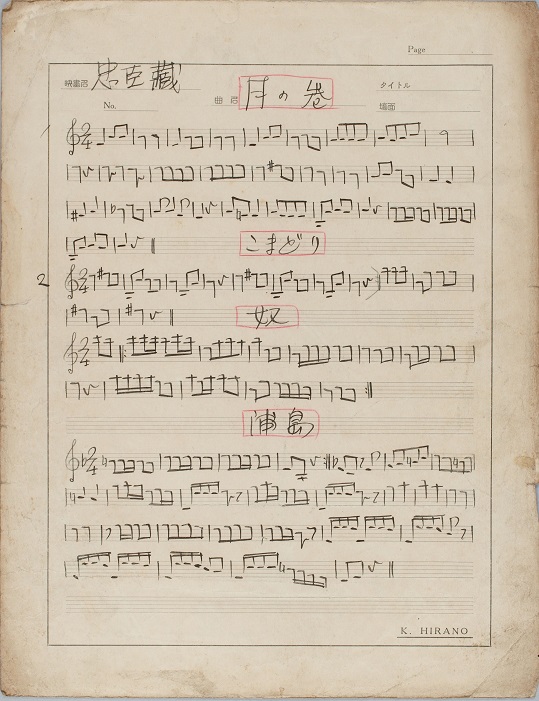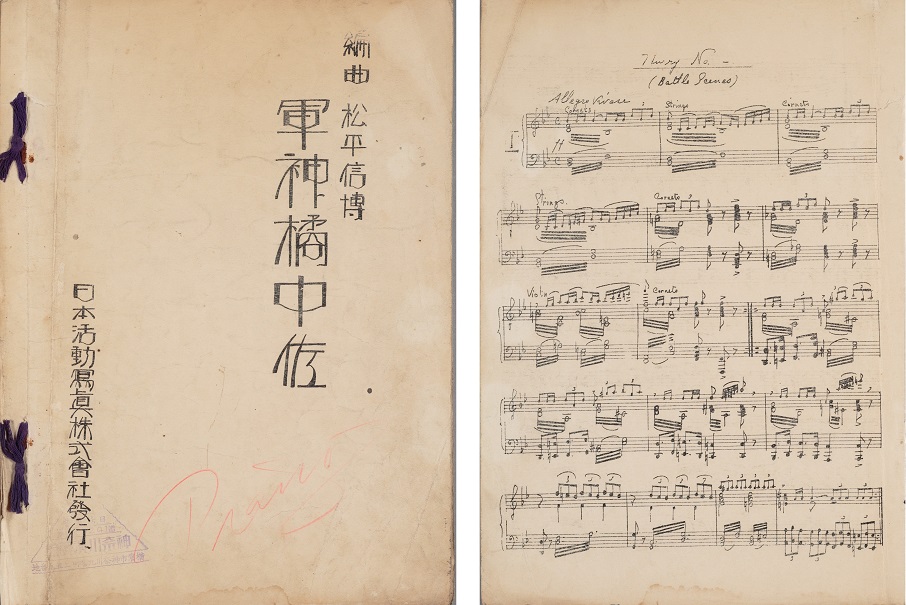Selected research project 2: Research on materials related to the presentation of silent films, and particularly their musical accompaniment
-
Principal Researcher: Seiji Choki (Professor, Graduate School of Arts and Sciences, the University of Tokyo)
Collaborative Researchers: Makiko Kamiya (Visiting Researcher, National Film Center, The National Museum of Modern Art, Tokyo),Fumito Shirai (Part-time Lecturer, College of Liberal Arts and Sciences, Tokyo Medical and Dental University), Kotaro Shibata (Doctoral Program, Graduate School of Humanities and Sociology, the University of Tokyo), Yohei Yamagami (Part-time Lecturer, Faculty of Music, Tokyo University of the Arts)
【Research objective】
The topic of this research is the Theatre Museum’s collection of musical scores used to accompany silent films produced from the mid-1920s to the early 1930s. According to the 2014 survey of the materials, the bulk consists of scores held by movie theaters, particularly Goraku-kan in Shinagawa under the direct management of the Nikkatsu Corporation, and materials held or used by Koichi Hirano (1898–unknown), a musician who worked in movie theaters directly run by Nikkatsu in the 1920s, such as the Goraku-kan. This study aimed to survey, primarily, the “Hirano Collection” and to clarify the cinematic practices in the Taisho and early Showa periods by analyzing the musical scores in particular.
【Summary of the research findings】
1.Background Research/Content Analysis of Score Materials
The scores were collected and used at least between 1924 and the beginning of the talkie era in 1933. We catalogued and collated score parts of music anthologies, such as the domestically published anthology Small Orchestra. These parts were supposed to be used infrequently, and as such, had remained unarranged (around 400 specimens). The analysis revealed that musical instruments were selected according to the size of the theater ensemble; handwritten parts (particularly for the shamisen) were added; and the score parts had a systematic collection and management.
2.Survey of Contemporaneous Documents and Relationship with other Score Materials
We collected and surveyed contemporaneous magazines and newspapers, such as Tokyo Engei Tshushin (Tokyo Performing Arts News), to examine the activities of contemporaneous musicians and the functions of musical performance as accompaniment to cinematic screening. We also compared the collection’s scores with those from the posthumous collections of Koka Sassa (Yorii-machi, Saitama Prefecture) and Nobuhiro Matsudaira (Toyota-shi/Matsudaira-go, Aichi Prefecture). This comparison provided a glimpse of a process whereby musical accompaniments to Japanese films permeated into Nikkatsu-run cinemas at the behest of Nikkatsu Corporation.
3.Examination of Score Materials for Each Work and Screenings Accompanied by Reconstructed Music
Scores preserved in the collection that were prepared for a specific work can be divided broadly into two categories:
・Compiled Score Handwritten by Hirano [Figure 1] (31 works and fragments of others)
・Compiled Score Distributed by Nikkatsu, in simple print form [Figure 2] (12 works and fragments of others)
For reference purposes, we screened two of these works: Lieutenant Colonel Tachibana, the War God [Gunshin Tachibana-chūsa] using a compiled score distributed by Nikkatsu (eight themes, including music taken from imported anthologies and military songs), and Chushingura using a compiled score handwritten by Hirano (nine themes, including classic traditional Japanese music and a piece composed by Nobuhiro Matsudaira). We analyzed the sources of the music, and, in collaboration with the performers, determined the setting of musical instruments, number of repetitions of each number, and the scenes they accompany. The screenings were important attempts in reconstructing historical practices. The experiment highlighted a number of issues such as how the score should be used, its relation to the narrator’s explanations, and discrepancies with the utilization of Western accompanying scores. It will be necessary to examine how to utilize the scores.


